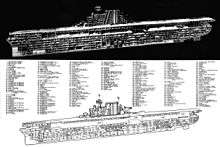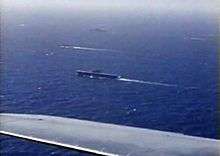Yorktown-class aircraft carrier
_underway_c1939.jpg) USS Enterprise | |
| Class overview | |
|---|---|
| Builders: | Newport News Shipbuilding |
| Operators: |
|
| Preceded by: | USS Ranger |
| Succeeded by: | |
| In commission: | 30 September 1937 – 17 February 1947 |
| Completed: | 3 |
| Lost: | 2 |
| Retired: | 1 |
| General characteristics | |
| Type: | Aircraft carrier |
| Displacement: |
|
| Length: |
|
| Beam: |
|
| Draft: |
|
| Propulsion: |
|
| Speed: | 32.5 kn (60.2 km/h; 37.4 mph) |
| Range: | 12,500 nmi (23,200 km) |
| Complement: | 2,217 |
| Armament: |
|
| Armor: |
|
| Aircraft carried: | 90 |
| Aviation facilities: |
|
The Yorktown class was a class of three aircraft carriers built by for the United States Navy and completed shortly before World War II. They immediately followed Ranger, the first U.S. aircraft carrier built as such, and benefited in design from experience with Ranger and the earlier Lexington class which were conversions of two battle cruisers into carriers that were to be scrapped to comply with an arms limitation treaty.
These ships bore the brunt of early action in the Pacific War, and two of the three were lost: Yorktown, sunk at the Battle of Midway, and Hornet, sunk in the Battle of the Santa Cruz Islands.
Enterprise, the sole survivor of the class, was the most decorated ship of the U.S. Navy in the Second World War. After efforts to save her as a museum ship failed, she was scrapped in 1960.
Development
A forerunner to modern weapons development, the Yorktown class was a result of standardized war gaming exercises using Langley and the Newport Naval War College. The Naval War College became the sole repository of American Naval expertise.[1] The results were that islands on the carriers were highlighted and speed itself was considered very important. The 27,000 ton plan for the Yorktown class was a fall back plan from a 23,000 ton carrier that could not achieve that desired speed. The realization that larger carriers would be more survivable was a happy coincidence. Nevertheless, the war games and the Naval War College highlighted the greater flexibility presented by large air groups and fast speed. These became along with torpedo protection, the guiding principles in the Yorktown class designs.[2] In particular, the 23,000 ton design had to sacrifice protection features and that along with the 60 aircraft limit led to the choice of the 20,000 ton design. All studies showed that the 27,000 ton designs were to be preferred however all treaty limitations made this impossible. Later it would be noted that the large carriers provided close to an all weather ability to launch aircraft.[3] The British Royal Navy had constructed several carriers during this time and the problems of flush deck carriers were revealed. Admiral Marc Mitscher had in particular pushed for such a carrier. The American Naval Attache J.C. Hunsacker reported that HMS Furious had problems deposing of the fumes without proper smoke stacks. The aviation community continued to demand flush decked carriers. Given additional problems with controlling air groups all American carriers would be constructed with islands. In any case BuAer retracted all demands for flush decked carriers. The 1931 design show an island and the design for USS Ranger the contractor stated that gun control was impossible without a raised island.[4] Both USS Ranger and USS Wasp further showed the limitations of sub-20,000 ton designs. USS Ranger proved to be unable to withstand rougher weather in the Pacific while lack of virtually any protective features soon relegated her to a training ship. USS Wasp's lack of torpedo protection contributed to her loss in the Pacific theater. The lessons learned from operations with the large converted battlecruiser Lexington class in comparison with the smaller purpose-built Ranger had taught the Navy that large carriers were more flexible in operational terms and were more survivable than smaller ones. As the result of this experience, the U.S. Navy built Yorktown and Enterprise, commissioned in 1937 and 1938 respectively. These were fast and versatile carriers able to carry and operate over 80 warplanes which was almost as many as the much larger Lexington class.

With the addition of the 14,700-ton Wasp, a scaled down version of the class, the U.S. Navy used up its full 135,000 ton Washington Naval Treaty limit of aircraft carrier tonnage. The abandonment of the arms limitation treaties system in 1937 allowed the US to begin building more carriers, and the first of this new carrier program was Hornet, another of the class, commissioned in 1941. Improvements to the Yorktown design and freedom from the Washington Treaty limitations brought about the Essex-class aircraft carriers.
Like the earlier ships of the Lexington class, the Yorktowns carried a seldom used catapult on the hangar deck level. This catapult was subsequently eliminated from U.S. carriers as it was relatively useless in operation. The hangar deck catapult was removed from Enterprise and Hornet in late June 1942.
All three ships of the Yorktown class were built at the Newport News Shipbuilding Company, Newport News, Virginia.
Ships in class
| Name | Pennant | Builder | Laid Down | Launched | Commissioned | Decommissioned | Fate |
|---|---|---|---|---|---|---|---|
| Yorktown | CV-5 | Newport News Shipbuilding and Drydock Co., Newport News | 21 May 1934 | 4 April 1936 | 30 September 1937 | - | Sunk by submarine following the Battle of Midway, 6 June 1942 |
| Enterprise | CV-6 | 16 July 1934 | 3 October 1936 | 12 May 1938 | 17 February 1947 | Struck 2 October 1956, Broken up at Kearny, New Jersey, 1958 | |
| Hornet | CV-8 | 25 September 1939 | 14 December 1940 | 20 October 1941 | - | Sunk following the Battle of the Santa Cruz Islands, 26 October 1942 | |
Operational history
The three ships of this class are noted for bearing the brunt of the fighting in the early months of the Pacific War, most notably during the Battle of the Coral Sea, the Battle of Midway, and the Guadalcanal campaign. During the latter campaign, Hornet and later Enterprise had the distinction of being the only operational carrier in the United States Pacific Fleet.
Enterprise was at sea on the morning of 7 December 1941: That evening, Enterprise, screened by six of her Grumman F4F Wildcat fighters, put into Pearl Harbor for fuel and supplies. The aircraft were fired on by anti-aircraft defenses, and one pilot radioed in, reporting that his aircraft was an American aircraft.[5] Enterprise later participated in the first offensive actions against Japan, launching attacks against the Marshall Islands, Wake, and Marcus Island.
Yorktown transferred to the Pacific on 16 December 1941 and later raided the Gilbert Islands in the same operation as Enterprise. Along with Lexington, she raided bases in New Guinea, then participated in the Battle of the Coral Sea. Her planes helped sink the Japanese aircraft carrier Shōhō and damaged the carrier Shōkaku. Damaged by Japanese carrier aircraft, Yorktown returned to Pearl Harbor and was hastily repaired in time to participate in the Battle of Midway.
Hornet spent the first months of the war training in Norfolk, Virginia, before being assigned to the Doolittle Raid. Loaded with a squadron of B-25 bombers and escorted by Enterprise, the ship launched the first air raids against the Japanese mainland.

All three ships of the class saw action during the Battle of Midway (4–7 June 1942), Enterprise and Yorktown aircraft were responsible for sinking all four Japanese carriers engaged in the battle, while Hornet assisted in the sinking of one heavy cruiser and severely damaging another. All three carriers suffered severe losses among their air groups, most notably Hornet's Torpedo Squadron 8, which lost 15 aircraft with only a single surviving airman. Yorktown was damaged by aerial bombs and torpedoes and abandoned on 4 June. Later re-manned by repair crews, the ship was spotted and torpedoed by a Japanese submarine and eventually sank on 7 June 1942.
Enterprise was assigned to the invasion of Guadalcanal and participated in preliminary strikes on the island. She suffered moderate damage during the Battle of the Eastern Solomons but was repaired in time to join Hornet in the Battle of the Santa Cruz Islands. Hornet was severely damaged during the latter engagement and had to be abandoned. Attempts to scuttle the ship by her escorts failed, and she was left adrift before finally being sunk by Japanese destroyers on 27 October 1942. Enterprise was again damaged during the battle, but was repaired enough to deliver her air group to Guadalcanal, where it participated in the Naval Battle of Guadalcanal. Enterprise aircraft assisted in finishing off the heavily damaged battleship Hiei and were instrumental in destroying the Japanese transport fleet, thereby ending Japan's last serious attempt at reclaiming the island.
After a lengthy overhaul and repair period at Bremerton, Washington, Enterprise joined the Central Pacific Fleet as part of the Fast Carrier Task Force. She participated in every major invasion of the Central Pacific campaign, including the Battle of the Philippine Sea and the Battle of Leyte Gulf. Her air groups contributed to the development of carrier night operations, executing a night air raid on Truk Lagoon and operating as a specialized night air group towards the end of the war.
Enterprise was finally put out of action on 14 May 1945 when she was struck in the forward elevator by a kamikaze aircraft flown by Japanese pilot Lt. Shunsuke Tomiyasu,[6] which destroyed the elevator and severely damaged her hangar deck. She was still out of action on V-J Day but was subsequently fitted out for Operation Magic Carpet, ferrying over 10,000 veterans home from Europe.
_awaiting_disposal_at_the_New_York_Naval_Shipyard_on_22_June_1958.jpg)
By the end of World War II, Enterprise had been considerably modified. Her final displacement was 32,060 tons and her final armament was 8 single 5-inch/38 caliber DP guns, 40 40 mm Bofors AA guns, 6 quad and 8 twin (replacing the ineffective 1.1"/75 caliber gun quad mounts which the Yorktown class had initially been fitted with) and 50 single 20 mm Oerlikon AA cannons. The Yorktowns had proved to be vulnerable to torpedoes, and while undergoing repairs at Bremerton, Washington, from July to October, 1943, Enterprise received an extensive refit, which included an anti-torpedo blister that significantly improved her underwater protection.
With the commissioning of the more advanced Essex and Midway-class carriers, Enterprise was surplus for post war needs. She entered New York Naval Shipyard on 18 January 1946 for deactivation, and was decommissioned on 17 February 1947. Stricken from the list in 1959 after multiple attempts to preserve her as a museum and memorial, ex-Enterprise met her fate in the breaker's yards at Kearny, New Jersey in 1960, although several artifacts were retained.
Notes
- ↑ U.S. Aircraft Carriers, Normand Friedman pg. 57 ISBN 0-87021-739-9
- ↑ U.S. Aircraft Carriers, Normand Friedman pg. 58-59 ISBN 0-87021-739-9
- ↑ U.S. Aircraft Carriers, Normand Friedman pg. 62 ISBN 0-87021-739-9
- ↑ U.S. Aircraft Carriers, Normand Friedman pg. 72 ISBN 0-87021-739-9
- ↑ "The Encyclopedia of Air Warfare" Salamander Books, Ltd., 1974. ISBN 0 690 00606 3.
- ↑ Naval Aviation news July August 1994
See also
References
External links
![]() Media related to Yorktown class aircraft carriers at Wikimedia Commons
Media related to Yorktown class aircraft carriers at Wikimedia Commons